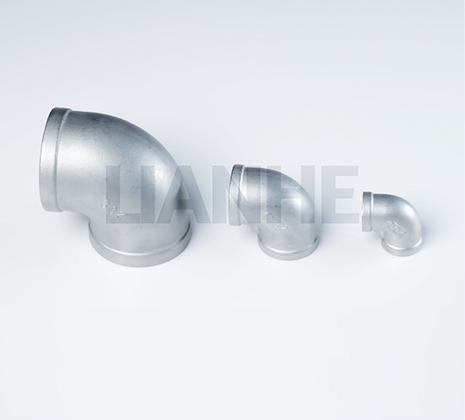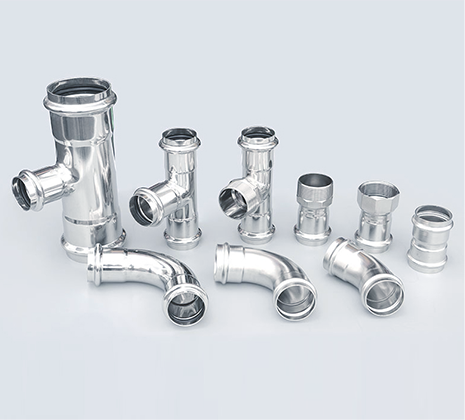Tel: +86-577-86801027 / E-mail: cooper@lianhevf.com
Stainless Steel Fitting
- All
- Product Name
- Product Keyword
- Product Model
- Product Summary
- Product Description
- Multi Field Search
Views: 0 Author: Site Editor Publish Time: 2025-04-16 Origin: Site











Stainless steel fittings are often overlooked, but they are crucial in many industries. Why is it the go-to choice for plumbing and heavy-duty systems? The answer lies in their strength, durability, and resistance to corrosion.
In this post, we’ll explore the key benefits of using stainless steel fittings, from their unmatched corrosion resistance to their ability to withstand extreme conditions. You'll learn why these fittings are the top choice for industries like oil and gas, food processing, and chemical plants.
When you’re working on a system that needs to withstand heavy-duty conditions, strength becomes a key factor. Stainless steel fittings offer superior strength compared to other materials, making them the perfect choice for both residential and industrial applications. Whether you’re building a simple plumbing system or working with large industrial pipelines, these fittings are engineered to handle high pressures and extreme temperatures. Their robust composition helps ensure that your piping systems stay intact without the risk of failure.
In fact, stainless steel fittings are often the first choice when systems need to manage extreme pressures and temperatures. Unlike other materials that can crack or fail under stress, stainless steel maintains its integrity, ensuring the flow continues smoothly without interruptions.
One of the primary reasons people choose stainless steel fittings is their remarkable resistance to corrosion. In environments where moisture, chemicals, or saltwater are common, corrosion can be a significant issue. This is where stainless steel excels. Thanks to its unique alloy composition, particularly the presence of chromium and nickel, stainless steel forms a protective layer that prevents rust and corrosion from forming.
For example, in the marine industry, where saltwater is a constant concern, stainless steel fittings are an absolute must. They resist the harsh effects of salt and water, making them more durable than other materials like brass or plastic. Similarly, in chemical processing plants, where exposure to aggressive chemicals is common, stainless steel offers an unparalleled ability to resist chemical damage.

Stainless steel fittings are built to last. They offer an incredible lifespan that can span several decades with minimal maintenance. This durability makes them a cost-effective option in the long run. Whether it's a domestic water system or an industrial pipeline, stainless steel’s resistance to degradation means fewer repairs and replacements, saving both time and money.
In fact, the life expectancy of stainless steel systems often exceeds 50 years, significantly reducing the need for system downtime or costly repairs. This makes it a perfect fit for applications that require longevity and reliability.
When it comes to industries like food processing, pharmaceuticals, and healthcare, cleanliness and sterility are critical. Stainless steel fittings are non-porous, meaning they don’t harbor bacteria, dirt, or grime. This makes them easier to clean and maintain, ensuring that the systems they’re part of stay hygienic.
In industries where sanitation is a top priority, like in the food and beverage industry, using stainless steel fittings ensures that the systems remain free of contaminants, which is crucial for maintaining safety and compliance with health regulations.
While the primary function of stainless steel fittings is to serve in plumbing and piping systems, let’s not forget the aesthetic advantages they offer. Stainless steel’s sleek, modern appearance makes it a favorite in architectural applications, too. Whether you’re designing a kitchen, a factory, or an office building, stainless steel can enhance the overall design while maintaining its functional role.
Moreover, stainless steel fittings come in various shapes and sizes, making them incredibly versatile. Whether you need a fitting to connect pipes at a 90-degree angle or reduce the diameter of a pipe, stainless steel can provide a solution that fits perfectly into your design.

In today’s world, sustainability is more important than ever. Stainless steel fittings are a greener choice compared to other materials. First, stainless steel is 100% recyclable. This means that when your fittings reach the end of their useful life, they can be repurposed without losing quality.
Additionally, the durability of stainless steel means fewer replacements, which reduces the environmental impact. Fewer replacements mean fewer resources are used to manufacture new parts, and less waste is generated. This makes stainless steel a highly environmentally friendly choice for both residential and industrial applications.
At first glance, stainless steel fittings may seem like a more expensive option compared to alternatives like plastic or brass. However, the long-term savings they offer make them a cost-effective choice. Their resistance to corrosion, strength, and durability mean that you’ll spend less on maintenance, repairs, and replacements over time. In the long run, stainless steel fittings are an investment that pays off.
Furthermore, the fact that stainless steel requires no additional coatings or treatments (unlike some metals that may require anti-corrosion coatings) makes it a more economical choice in many cases.
Stainless steel fittings are used across a wide range of industries. Let’s take a closer look at some of the most common applications:
In the oil and gas industry, pipelines are exposed to extreme conditions. From high pressures to corrosive chemicals, the environment can be tough. Stainless steel’s ability to resist corrosion and withstand high temperatures and pressures makes it an ideal choice for this sector. Stainless steel fittings are used to connect and secure pipes in oil rigs, refineries, and pipelines, ensuring safe and efficient operations.
Chemical processing plants handle harsh substances that can damage pipes over time. Stainless steel fittings provide the necessary durability to handle these chemicals without breaking down. Their resistance to corrosion and chemical reactions ensures that the system remains intact, even in the most aggressive environments.
The food and beverage industry requires systems that are both durable and easy to clean. Stainless steel fits the bill perfectly. Not only does it resist bacteria growth, but its non-porous nature makes it easy to sanitize. Whether used in beverage systems, food production lines, or storage tanks, stainless steel fittings help maintain the hygiene standards required in this industry.
In water treatment plants, stainless steel’s resistance to corrosion and chemical exposure makes it an excellent choice for handling both clean and wastewater. Stainless steel fittings ensure that the flow remains intact and leak-free, helping to maintain the integrity of the water treatment system.
Stainless steel fittings are also used in construction for both practical and aesthetic purposes. Their ability to withstand harsh weather conditions and resist corrosion makes them ideal for outdoor and structural applications. In addition, the sleek appearance of stainless steel adds a modern touch to architectural designs.

Selecting the right type of stainless steel fitting depends on the specific needs of your project. Some of the common types of stainless steel fittings include:
Elbow fittings – Used to change the direction of the flow.
Tee fittings – Used to connect three pipes at a 90-degree angle.
Reducers – Used to connect pipes of different sizes.
Caps – Used to seal the end of a pipe.
Each type of fitting is designed to perform a specific function, and choosing the right one will depend on your system’s requirements.
In summary, stainless steel fittings offer a variety of advantages, from strength and durability to corrosion resistance and hygiene. Whether you’re working on a residential plumbing project or an industrial pipeline, stainless steel provides the reliability and performance you need. If you’re looking for fittings that will stand the test of time, provide long-term savings, and contribute to a greener environment, stainless steel is the way to go.
For high-quality stainless steel fittings, visit us!
Q: What are stainless steel fittings used for?
A: Stainless steel fittings are used to connect pipes in various systems, including plumbing, chemical processing, and oil and gas pipelines. They help manage fluid and gas flow while maintaining strength and durability.
Q: Why are stainless steel fittings better than brass?
A: Stainless steel fittings offer superior corrosion resistance, making them ideal for harsh environments. They also have a higher strength-to-weight ratio and a longer lifespan than brass.
Q: Can stainless steel fittings withstand high temperatures?
A: Yes, stainless steel fittings are known for their ability to withstand high temperatures, making them ideal for industrial applications that involve heat or steam.
Q: Are stainless steel fittings environmentally friendly?
A: Yes, stainless steel is 100% recyclable and has a long lifespan, which reduces the need for frequent replacements. This makes stainless steel fittings an environmentally responsible choice.
Q: How do I maintain stainless steel fittings?
A: Stainless steel fittings require minimal maintenance. Regular cleaning with water and mild detergent is usually sufficient to keep them in good condition. They do not require special coatings or treatments.